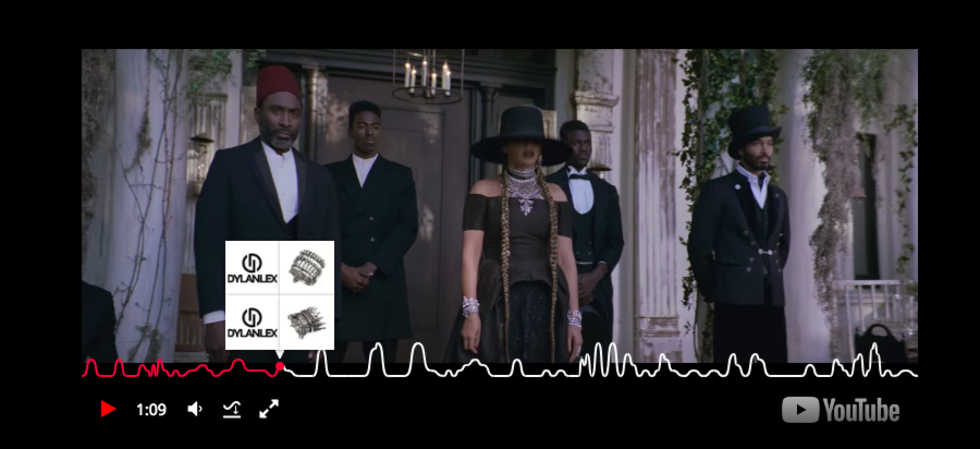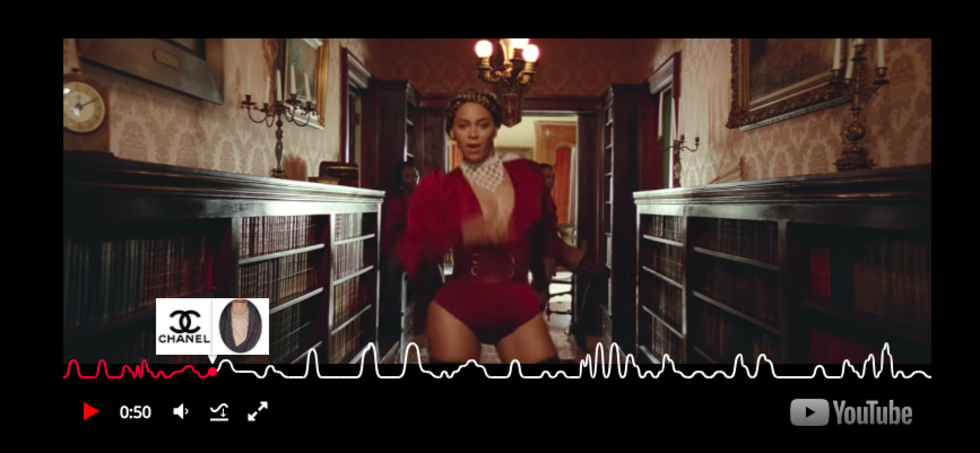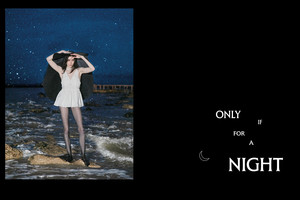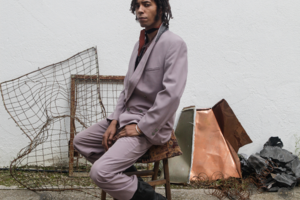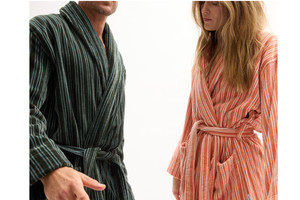TAGFLIX: CREATING A NEW INTELLECTUAL VIDEO EXPERIENCE
Written by Ksenia RundinDo you remember the enchanting plot and exuberant intrigues of the American television soap opera ‘The Bold and the Beautiful’, taking place around the Forrester family and their fashion business? At the beginning of the 1990s, when I just became a teenager, I could not help but admire the geometric elegance of the opulent suits and accessories, exquisitely worn by treacherous Stephanie Douglas and diligent Brooke Logan. The chic boldness of meticulously organised scenography interior designs that bestowed the intimate feeling of glamour, created a true moment of experience with each new scene. Nevertheless, my avid curiosity about those peculiar details, which practically held the dramatic and cultural frame of the whole story, had never been satisfied.
Today, twenty years later, Tagflix comes with a revolutionary solution, enabling people to find things they desire in any video through a simple touch of the digital screen. Being sincere visionaries of their time, the Tagflix team, - similar to da Vinci, once carefully sketching out his flying machine, modelled after the anatomy of birds and bats, - by following the spiritual anatomy of the human desire and curiosity, bring people and knowledge together in a video format. While, in an unobtrusive way, serving a consumer with the information on details presented in a video, the company simultaneously creates a vitally important analytical data for the brands engaged. Thus Tagflix conceives a bilateral communication tool with immediate intellectual effect. Providing the consumer with knowledge and thus enabling one to keep the freedom of choice in place, Tagflix’s invention helps different brands to uphold the democracy of consumption and to discover new markets. The company makes the future happen today by bringing the past ahead, visualizing the knowledge and marrying the latter to the moment of creative experience.
Discovering new potential of the video as a source of information and communication, the Californian team create a totally new ecosystem, which brings the consumer onto the intellectual arena of the marketing communication and turns her into an equal player. It is a silent way to market the goods and services, where the consumer bases the decision on an intellectual experience. Hence, leading our discussion back to the cult series of the early 1990s, we would today be able to learn about screenwriting, fashion and design, art and film history by simply putting our index finger towards the item we are curious about on the screen. Furthermore, the discovered knowledge can also be shared with friends through social media channels, what also opens up for new interactions such as communities, where consumers can exchange their interests and passions, learning from each other and creating new discourses.
This summer, Odalisque Magazine met one of the co-founders of Tagflix, Marcus Ehrenblad in Stockholm and talked with him about the company, sustainability, luxury and their plans for the future. Seemingly, the time for creating a new type of consumer, who makes own decisions and takes responsibility for those, has come.
The concept of Tagflix derives from the avid consumers of online video, who created a certain consumer-for-consumer product. Could you describe the main stages of your establishing process from the moment you first came up with the idea of creating Tagflix till the day you could present a complete product for the market?
My co-founder Tim and I initially started another company that did crowd equity funding that we did not pursue due to very restrictive US license laws. That same week Tim and I were having a drink and watching TV at my place trying to work out what to do next. It was then, when I saw a really cool shirt on TV and pointed this out to Tim and he picked up the remote, pointed it at the screen and said as a joke, ‘I just bought it for you!’ That is how it all started. As two tech nerds, we asked ourselves, ‘How could you actually make that work?’ We thought it was going to be simple, but it was not, yet five years on we are now sitting here with you having this exact discussion.
We realised that we had to put the video content and audience first by making the experience unobtrusive and remove annoying ads or gamification that seemed to be happening in the industry. Therefore we had to take a completely new approach that would enable a better, more natural user experience that focused on discovering the things people loved in video, and also give brands and publishers the deep insights they needed to be successful and improve their content.
How will you accomplish to stay unique with your invention and protect yourself against IP-infringement?
We are fortunate to have some of the most passionate designers and engineers I've ever worked with on our team. Aside from being very easy to work with, their drive to exceed expectations pushes us to solve problems in unique ways. Pairing that with a reputable Intellectual Property Rights firm, we were able to patent our flagship user experience as well as the Video Graph backend technology.
Behind the scenes is where it gets really interesting. We connect all many stakeholders in the value chain and combine the data (from viewers, publishers, advertisers, agencies, brands, product placement companies and ecommerce providers and content creators). This not only creates never before available insights to brands, it also allows us to form a complete ecosystem. We want others to build on top of our core technology, so that we become the industry standard. We believe this will provide a good barrier to entry and build a very interesting business.
What impact do you think the Tagflix program will have on the brand equity of the luxury segment companies within the fashion industry?
That is a great question and the answer is twofold. Firstly, we have created the ability to measure the impact of products and brands in video content, so that it can then be managed and improved over time. Secondly, we see a future where normal TV ads are disappearing as well as pre-rolls and mid-roll ads (interstitials) in favour of more Netflix style viewing. In essence, obtrusive video ads will decline overtime as a percentage of views. This means brands need to expose themselves elsewhere and through Tagflix they can do this while also being able to measure such exposure more accurately than ever before. With access to such data, brands are able to make better content decisions at creation stage. For fashion, it means we can better tailor clothing for the content being produced. No pun intended.
We also believe it has a positive impact as larger brands have all told us that mono branded content as well as conventional advertising mediums are really struggling to reach their target audience. We provide deep consumer insights that tell brands which demographics are actively engaged in terms of brand uplift as well as social shares and whom are selling their products in which categories of videos. The net effect is that brands can now measure the competitor landscape including share of voice inside videos.
Do you think that by offering Tagflix – an omni-channel marketing strategy tool for your customers, you might create a challenge for such intermediators as influencers/bloggers by making their services redundant?
On the contrary, Tagflix provides an additional revenue stream for influencers and bloggers. I would like to believe we are adding to their toolset and already see some vloggers as early adopters. Through Tagflix insights, they can demonstrate to brands the value they bring. The platform tools and metrics also help them optimise their campaign performance - all delivering more value to their brand clients, and differentiating from the competition. The Tagflix toolset only compliments bloggers and influencers as they publish smart videos across social platforms consumed by a more targeted audience.
Influencers are also under huge pressure to prove their value is authentic, as brands become increasingly sophisticated and aware of ‘fake followers’. Given Tagflix measures all video interactions, it makes this much more difficult to fake, similar to how a capture code requires interaction by a real human user to proceed. The platform can detect patterns of usage which are more robotic verses those that are more authentic, and only the authentic interactions are considered.
Does Tagflix contribute to the circular economy and the field of sustainability?
Sustainability is actually one of our core values at Tagflix. We are in this for the long term as indicated by our persistence over the last five years. For a marketing industry worth $550B, there are inefficiencies we have identified and working on optimising as part of our strategy.
How do you store all the data collected on customer behaviour and audience interactions? Who is responsible for that data?
At a high level and like most tech start-ups these days we leverage the full benefits of the cloud. We take a best of breed approach favouring the right tools for the right job, so our data does not necessarily sit in the same place all the time. All our partners are GDPR certified and we take extra precautions to pseudo anonymise our data and have strict controls for reporting. We ensure our reporting data can never be tied back to specific users.
Are you considering to enter new markets, for instance the art field or the educational field?
Yes, eventually. Our value proposition is to allow users to discover anything within video whether it's a commercial product in a music video or information about something they have seen like a piece of art or an animal in a documentary. This however needs to be rolled out in stages and managed very carefully. If we claim to be able to document everything in every video on day one, then it is very difficult to keep that promise to our users. Given we are a big data company, data drives our strategy and we intend to do the same when considering new markets, partners and audiences as they become available. The ultimate goal is to become the de facto standard for video metadata, and so far we are on the right track. We happen to be focused on fashion, music and the arts at the moment.
Are you engaged into any charity projects?
Not yet but are very excited about any prospects of getting engaged with such projects. Another core value we embody is persistent problem solving and are definitely keen to work out other ways our technology and data can help, be it charitable or major world problems.
We can also add our clients desired charities to Smart Video to help drive audience engagement and donations. This will really help charities raise their profile, and build stronger associations with the brand and business partners. This is a great way for business to build loyalty with their audiences.
Could you name any interesting projects you are engaged into within fashion field?
Real-time product tracking of livecast catwalks is something we are exploring and considering as an exciting prospect. The introduction of the Smart Video dashboards, and the audience insights that accompany them, will have a massive impact on how fashion brands understand what products work within video and with who. Allowing them over time to make video content better, and even help them understand what designs their audiences are interested in - this may even impact what makes it to shelves.
Artificial intelligence (AI) and the digital field as such are constantly evolving and changing areas. Do you practice foresight and trend spotting in your company in order to stay relevant on the market? For example future- and customer-oriented prioritisation of innovative ideas, product innovations or process innovations?
In general, we are highly customer focused. AI is a fantastic tool to give our customers a better experience, and when something better comes along, you can bet our team is exploring it. As it turns out, when you aim to best serve your customer, the side effect is that you remain relevant. Looking outwards at the competition and trend spotting has its merits, however coming back to sustainability discussed earlier, we know there will always be times we are ahead of the competition and at other times they will be ahead of us. That is the game every business plays with each other everyday. What is in our control, is our team's ability to hire the right talent that share our value of exceeding expectations and delivering the best outcomes for our customers.
How in such a case do you engage in foresight on the managerial level?
In this very new space we have created, it is very difficult to predict what will happen or be needed in the future. We rely on our data to give us hints as to what market shifts are taking place and explore options as a management team from there. For example, the insights we provide about what products and designs are resonating most with viewers of fashion shows may have a significant influence on what designs make it off the catwalks and onto high street shelves, but until we try it, no one can predict the impact. The good news is, our platform is designed just for measuring such cases and has the ability to tie every engagement back to the original investment.
Do you have any managerial strategy for it?
This is part of our DNA as a data driven tech company and see this process as part of a continuous feedback loop from users, clients and our people within the company.
How do you communicate results?
We provide real time dashboards to our clients and they are able to see the performance and insights from a video nearly immediately.
How do you evaluate efforts?
It highly depends on the situation and what it is we are evaluating. For a product, we typically we use a/b testing approaches whereby some of our customers chosen at random will see one design and the remaining another. If feedback for the second design is more positive, we go with the second implementation. Sometimes you get a mix of good and bad from both datasets, and then we take the best bits and trial a third revised option. We also like Simon Sinek’s method of always starting with the Why, then How and lastly What. In our customer centric model, we typically pursue a project or task if the why makes sense first.


